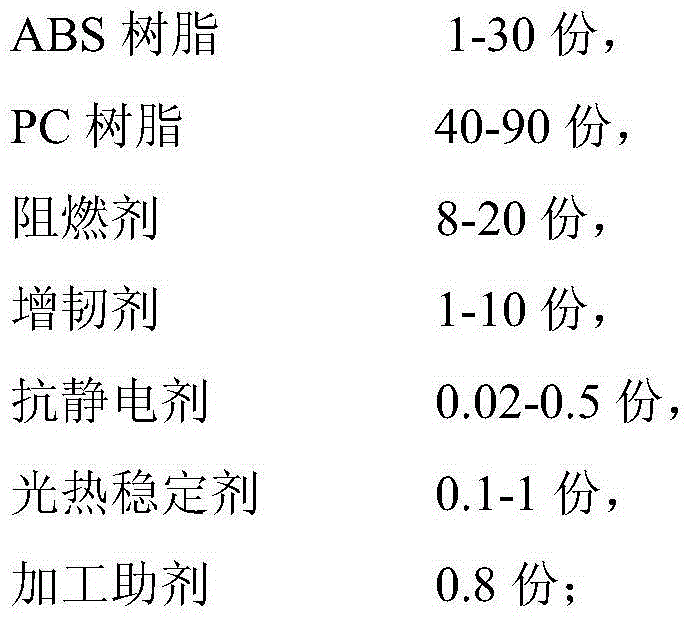A kind of halogen-free flame-retardant antistatic pc/abs alloy material and preparation method thereof
A flame retardant antistatic, alloy material technology, applied in the field of alloy materials, can solve the problems of abnormal operation of integrated circuit chips, loss of antistatic effect, short antistatic time, etc., to achieve good appearance, excellent antistatic performance, and product quality stable effect
- Summary
- Abstract
- Description
- Claims
- Application Information
AI Technical Summary
Problems solved by technology
Method used
Image
Examples
Embodiment 1
[0041] With 1 part of ABS Daqing 750, 90 parts of PCIR2200, 8 parts of flame retardant BDP, 0.02 part of antistatic agent multi-walled carbon nanotubes, 1 part of MBS toughening agent, 0.3 part of light and heat stabilizer (1076:168=1: 2) and 0.8 parts of processing aids (0.5 parts of EBS and 0.3 parts of PTFE-A3800), mixed evenly by high-speed stirring, and the above mixture was sent into a twin-screw extruder, and fully melted under the conveying and shearing action of the screw , composite, and then extruded through the machine head, drawn, cooled, pelletized, and finally packed.
[0042] The screw temperature of each section of the twin-screw extruder is controlled between 230-250°C, and the screw speed is 400 rpm.
[0043] The prepared compound was injection-molded into a standard sample bar for testing according to the standard size, and the performance test results are shown in Table 2.
Embodiment 2
[0045] With 10 parts of ABS Daqing 750, 74 parts of PCIR2200, 13 parts of flame retardant BDP, 0.1 part of antistatic agent multi-walled carbon nanotubes, 3 parts of MBS toughening agent, 0.3 part of light and heat stabilizer (1076:168=1: 2) and 0.8 parts of processing aids (0.5 parts of EBS and 0.3 parts of PTFE-A3800), mixed evenly by high-speed stirring, and the above mixture was sent into a twin-screw extruder, and fully melted under the conveying and shearing action of the screw , composite, and then extruded through the machine head, drawn, cooled, pelletized, and finally packed.
[0046] The screw temperature of each section of the twin-screw extruder is controlled between 230-250°C, and the screw speed is 400 rpm.
[0047] The prepared compound was injection-molded into a standard sample bar for testing according to the standard size, and the performance test results are shown in Table 2.
Embodiment 3
[0049]With 15 parts of ABS Daqing 750, 65 parts of PCIR2200, 15 parts of flame retardant BDP, 0.3 part of antistatic agent multi-walled carbon nanotubes, 5 parts of MBS class toughening agent, 0.3 part of light and heat stabilizer (1076:168=1: 2) and 0.8 parts of processing aids (0.5 parts of EBS and 0.3 parts of PTFE-A3800), mixed evenly by high-speed stirring, and the above mixture was sent into a twin-screw extruder, and fully melted under the conveying and shearing action of the screws , composite, and then extruded through the machine head, drawn, cooled, pelletized, and finally packed.
[0050] The screw temperature of each section of the twin-screw extruder is controlled between 230-250°C, and the screw speed is 400 rpm.
[0051] The prepared compound was injection-molded into a standard sample bar for testing according to the standard size, and the performance test results are shown in Table 2.
PUM
| Property | Measurement | Unit |
|---|---|---|
| density | aaaaa | aaaaa |
| melting point | aaaaa | aaaaa |
Abstract
Description
Claims
Application Information
 Login to View More
Login to View More - R&D
- Intellectual Property
- Life Sciences
- Materials
- Tech Scout
- Unparalleled Data Quality
- Higher Quality Content
- 60% Fewer Hallucinations
Browse by: Latest US Patents, China's latest patents, Technical Efficacy Thesaurus, Application Domain, Technology Topic, Popular Technical Reports.
© 2025 PatSnap. All rights reserved.Legal|Privacy policy|Modern Slavery Act Transparency Statement|Sitemap|About US| Contact US: help@patsnap.com

